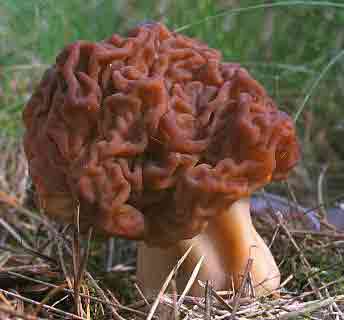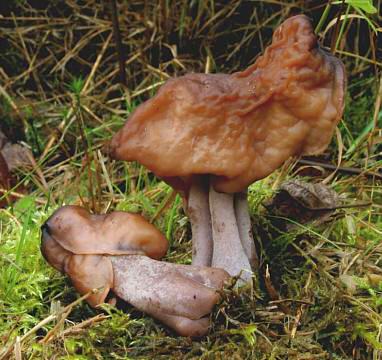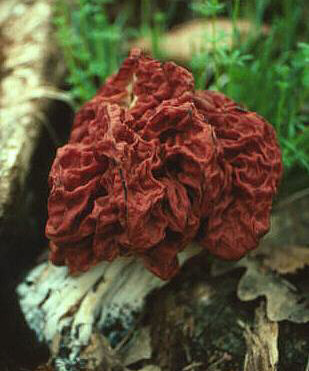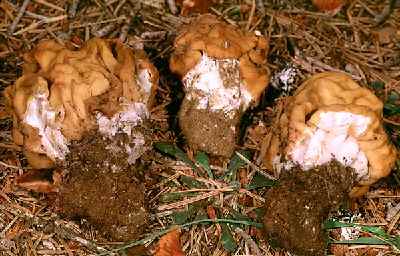Elite life |
 |
|
Mushrooms |
Gyromitra |
|
Species in the genus Gyromitra vary widely in appearance. Some species
are cup-shaped and have rudimentary stems. Other species are more
familiar, especially to morel hunters, and these mushrooms are often
collectively referred to as the "false morels." They have well developed
stems, and their oddly shaped caps are generally reddish brown to
yellowish brown. When sliced open, they are not completely hollow--and
this is the best way to distinguish them from the morels, which are
hollow. This is an important distinction, since false morels are
poisonous, and none of them should be eaten. |
|
║ Mushrooms ║ |
False Morel, Brain Mushroom, Beefsteak Morel (Gyromitra esculenta) |
 |
|
|
|
Gyromitra
esculenta is a beautiful springtime mushroom frequently found by morel
hunters in northern and western areas of the continent. It can be
distinguished from other false morels by its brainlike, reddish brown,
irregular cap, and by the fact that its stem is not massive in
proportion to its cap. In dry weather conditions, these mushrooms can
blacken and dry up and last for an amazingly long time on the forest
floor. Found in spring, primarily under conifers; widely distributed in
northern and montane North America. |
Description:
Cap
3-11 cm across, brain-like, irregularly rounded, and somewhat flattened;
reddish brown or darker, yellowish brown in some forms; sometimes almost
smooth, but generally intricately wrinkled and folded but not pitted.
Stem 20-50 x 15-40 mm, stuffed becoming hollow in chambers, equal or
expanded at either end; pale flesh-colored; smooth or faintly grooved.
Flesh thin and brittle. Spores ellipsoid, smooth, containing 2 or more
yellowish oil droplets, 18-22 x 9-13 μm. |
Elfin Saddle (Gyromitra infula) |
 |
|
This mushroom occurs in late summer and fall--not in the spring, when
the other Gyromitras can be found (in coastal California, however, it
fruits in winter and spring). Its broadly lobed cap is usually pinched
into two lobes, creating a saddle-shaped appearance. Its color is
extremely variable. The West Coast version of Gyromitra infula tends to get larger than its
eastern counterpart, and seems more prone to 3-lobed and odd-ball
manifestations. Additionally, this western mushroom is sometimes found
growing terrestrially, while the eastern version is almost always found
growing on wood. Found on the ground and on rotting wood; widely
distributed in North America. |
Description:
Cap: 3-12 cm; occasionally cup-shaped when young, becoming lobed with
two prominently raised lobes (rarely with 3 or 4 lobes); not brainlike;
color extremely variable (tan to yellowish brown to reddish brown to
dark brown); underside paler, sometimes ingrown with stem where contact
occurs.
Flesh: Thin and brittle; insubstantial or chambered.
Stem: 1-12 cm; not ribbed; colored like the cap or paler, frequently
whitish.
Microscopic Features: Spores 17-23 x 7-10 μm; oblong to elliptical;
with two large oil droplets, including a blunt apiculus at each end. |
Big Red, Beefsteak Mushroom (Gyromitra caroliniana) |
 |
|
This springtime false morel is common in the south, and in the
Mississippi and Ohio valleys. Despite the fact that it is consumed by
many, this mushroom is not a safe edible. Gyromitra caroliniana can be
distinguished from other Gyromitra mushrooms by its geographic range,
its large, white stem, its heavily stuffed and chambered interior, and
its cap, which is reddish brown and rather tightly stuck to the stem.
The cap surface varies from almost brainlike to nearly "pitted and
ridged," like Morels. When sliced open, Gyromitra carolinia specimens
often feature chambered flesh near the cap surface that is reminiscent
of broccoli spears. Found under hardwoods in spring; widely distributed
in eastern North America from Kansas to the East Coast, but especially
common in the south and in the Mississippi and Ohio watersheds. The
northern edge of its range appears to be the southern Great Lakes. |
Description:
Cap: 5-10 cm; variable in shape but generally tightly affixed;
brainlike to pitted and ridged; reddish brown; underside paler, ingrown
with stem where contact occurs.
Flesh: Whitish or flushed rose; brittle; chambered; without a central
cavity.
Stem: 6-10 cm long; pale tan to pure white; large, sometimes massive;
smooth; sometimes discoloring grayish on handling.
Microscopic Features: Spores 30-32.5 x 11.5-14 μm; with 1 large oil
droplet and 2-3 smaller ones. |
Snow Morel (Gyromitra montana) |
 |
|
Solitary, scattered, to gregarious in soil, humus, occasionally with
rotting wood, under conifers, near melting snowbanks; found at higher
elevations of the Sierra and presumably also Coast Range; fruiting
during the spring. |
Description:
Pileus: ap 5-10 cm broad, 4.0-7.0 cm tall, fertile surface convoluted,
folded, rarely lobed; margin irregular, incurved, closely pressed or
fused to the stipe; surface yellowish-brown, hazel-brown, to dull
reddish-brown in age; sterile undersurface whitish; context thin,
1.0-2.0 mm thick, brittle; odor and taste not distinctive.
Stipe: Stipe short, stout, 2.0-8.0 cm tall, 3.0-7.0 cm thick; surface
whitish, grooved to folded, the latter manifested in cross-section by
longitudinal passages.
Spores: Spores 25.0-35.0 x 12.0-16.0 μm, elliptical, smooth, some
with thickened ends (apiculi), possessing a single, large central oil
droplet. |
|
|
|
║ Mushrooms ║ |




